25. BILL CLINTON: BOOMER REALIST

CLINTON AND THE WORLD
CONTENTS
 American intervention in Somalia (1993) American intervention in Somalia (1993)
... and lessons learned
 Clinton's efforts to bring peace between Clinton's efforts to bring peace between
Israel and Palestine (1993)
 Restoring Haiti's presidency (1993-1994) Restoring Haiti's presidency (1993-1994)
 Ethnic cleansing in Rwanda (1994) Ethnic cleansing in Rwanda (1994)
 Ethnic cleansing in Bosnia (1991-1995) Ethnic cleansing in Bosnia (1991-1995)
 The Kosovo Crisis (1999) The Kosovo Crisis (1999)
 Relations with former Cold War rival Relations with former Cold War rival
Russia now seem to be quite warm
 Diplomatic progress in Europe Diplomatic progress in Europe
 Saddam Hussein's Iraq Saddam Hussein's Iraq
 Problems brewing in the Muslim world Problems brewing in the Muslim world
The textual material on this webpage is drawn directly from my work
America – The Covenant Nation © 2021, Volume Two, pages 323-334.
AMERICAN INTERVENTION IN SOMALIA (1993) TEACHES CLINTON THE PERILS OF "NATION-BUILDING" ABROAD |
|
"Black Hawk down" in Somalia (1993)
Clinton's first serious venture into foreign
affairs turned out to be a disaster, but thankfully only a small
disaster. The country Somalia was caught in a massive civil war among
contending tribes and religious groups, and was turning into a
humanitarian disaster as warring political factions confiscated the
United Nations food donations sent to relieve the starving Somali
civilian population. In October of 1993, in order to bring better
protection to the U.N. relief effort, Clinton ordered a land and
helicopter assault from offshore aircraft carriers on one of the major
warlords. But two Black Hawk helicopters were shot down and a rescue
attempt was itself badly battered by resisting Somalis. The Americans
eventually pulled out as best they could.
The whole thing was reminiscent of
Reagan's attempt to referee the infighting in Lebanon in 1982-1983.
Despite the obvious humanitarian intentions of both interventions, they
both suffered from a violent resolve of local fighting groups not to let
these "outsiders" succeed in placing their police powers over their
country.
The complexities of nation-building
Westerners, especially Americans, have
always seen great honor in their interventions abroad, undertaken with
the high moral intentions of bringing peace to a society caught up in
terrible infighting, sometimes even precipitated by the Americans
themselves when they see fit to overthrow – in the name of democracy –
some national dictator. Americans have always been expecting that
somehow such intervention in the name of the freedom of the little
people would bring the wonderful experience of social justice to their
society – and thus ultimately win the hearts of that population. When
this does not happen automatically, dismay – rather than resolve to
understand the underlying dynamic – is the result.
This does not mean that such intervention
should never be attempted. It only means that "nation-building," which
is what is actually going on in these efforts, is a highly complex
matter involving the complicated putting in place of a workable status
quo where obviously one has broken down or has never possessed much
strength and thus stability, or has been dependent entirely on the
power of a single individual, thus to Americans, by very definition, a
dictator. However, "democracy" never happens automatically, through
some kind of spontaneous movement of the little people, freed up (by
the American intervention) to now be able to move forward as by some
deep human instinct toward some kind of orderly society. Inevitably the
peace and social stability America is looking for does not come about
until a new set of social "enforcers" are put in place, ones who are
able gradually to institute a new rule of some kind of social order
that the people can readily understand, thus one built on their longer
political-cultural norms, whatever they might be, not on America's
ideas of what those should be.
There are going to be firefights among
militant wannabes who seek to be the ones privileged to put that new
order in place. Outsiders are going to get caught in the middle of the
firefights, and are either going to have to impose their own sense of
order (which constitutes imperialism) or simply stand back and wait for
all the killing to subside and the social-political dust to settle to
be able to deal in some kind of orderly fashion with the winners of the
contest.
This does not fit the American Idealist,
Humanist, or Liberal view of human nature and how it is supposed to
work, that is, social progress through simple "appeal to Reason." This
is because domination, not reason (although "reason" always finds a way
eventually to assign moral justification to such domination), is what
secures social life. President Wilson never figured this out about the
Paris peace treaties and why the English and French refused to be
"reasonable" in their treatment of Germany in 1919. Presidents Kennedy
and Johnson (and the Democratic Congress of the early 1970s) did not
understand this about Vietnam. President Carter took too long to figure
this out about Iran. Reagan learned fast in Lebanon. Bush Sr.
understood, and refused to get drawn into nation-building in Iraq. As
we shall see in the next chapter, Bush Jr. however did not – and
everyone paid a huge price for Bush Jr.'s lack of political-cultural
sophistication.
For that matter, American intellectuals
of the Idealist, Humanist, or Liberal variety have never understood –
or even wanted to understand – this hard reality, the one that dictated
the manner of the founding of Anglo-American society in the New World,
and its expansion across the North American continent, from the
Atlantic to the Pacific. The sheer "imperialism" of it all has been a
constant affront to their religious belief in the reasonableness of man
and the Humanist view that violence is automatically evil – because it
makes a mockery of Human Reason. The facts of the founding and
expanding of Anglo-American culture are consequently too uncomfortable
(actually even shameful) for them to be willing to accept. And thus
they have the constant emotional need to apologize for the American
past, even for the very existence of America itself, and seek all kinds
of moral amends to make things right. Indeed, the shaming of America
seems to have become one of their major occupations in life, as if this
somehow might change the way Reality works – and finally justify their
Humanist religion.
Nonetheless Clinton learned quickly
through his Somali venture the hard lessons about political Reality
(his Georgetown training was probably also a big help in this regard).
Clinton would not totally reject the challenge of nation-building. But
he would be better-equipped in the future to deal with the actual
dynamics of such an enterprise.
|
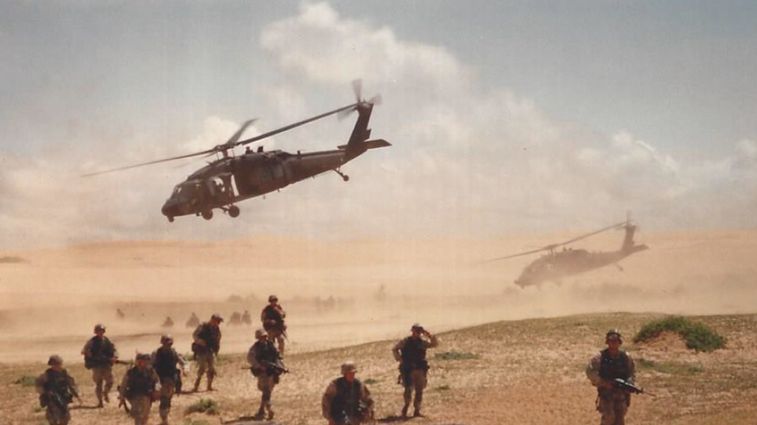
Going after the warlords in
Somalia
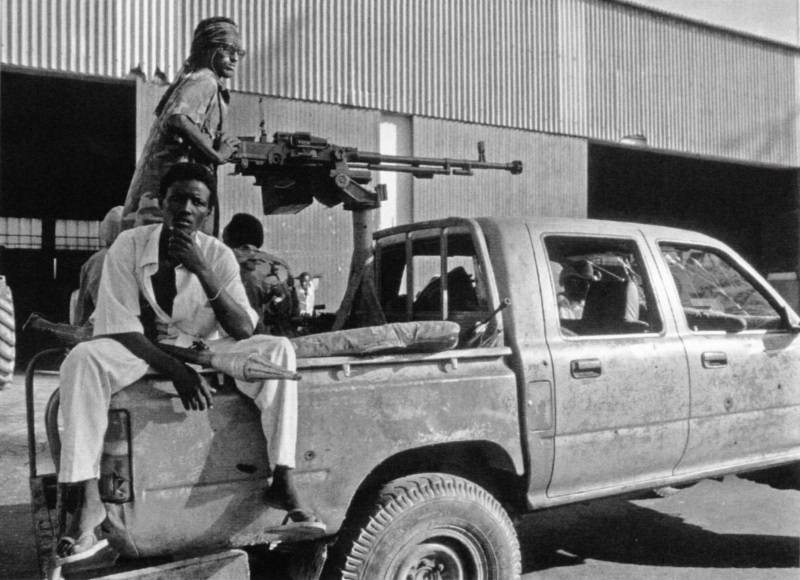
Troops of one of the
warlords
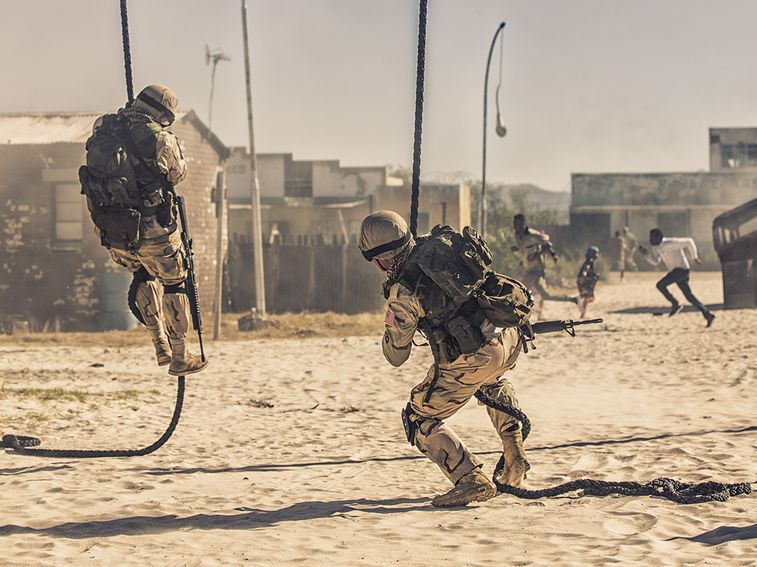
Dropping troops into Mogadishu by
helicopter
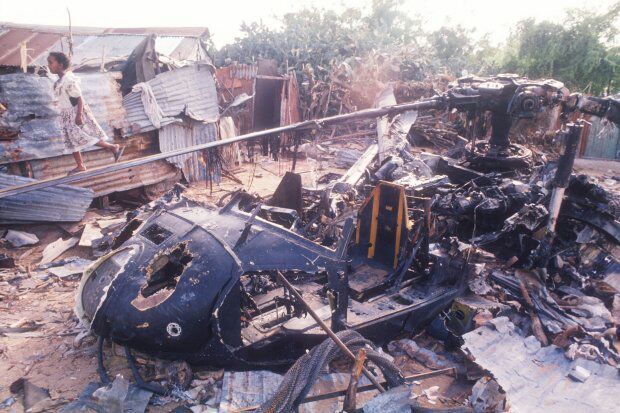
But two Black Hawk helicopters are down ... and at this point the goal switches
from
trying to seize Mogadishu to simply getting our downed soldiers out of
Mogadishu.
A hard lesson is learned:
beware of trying to save societies whose
leaders do not want to be "saved."
CLINTON'S EFFORTS TO BRING PEACE BETWEEN ISRAEL AND PALESTINE (1993) |
|
The Oslo Accords, September 1993
Also to Clinton's great credit, in 1993 it looked
as if Clinton might have pulled off the amazing agreement of Israel and
the Palestinians to work together with the signing of the Oslo Accords
– except that in November of 1995 a fanatical arch-conservative Jew,
Yigal Amir, assassinated the Israeli Prime Minister, Yitzak Rabin, for
having moved to accommodate the Palestinians.
Israeli-Palestinian tensions thus returned "back to normal."
|
The Oslo Accords attempt
to secure an Israeli-Palestinian Peace
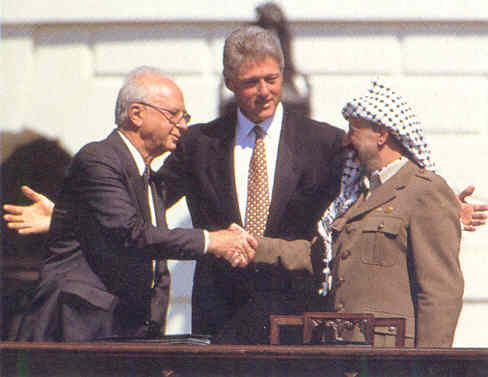
Yitzhak Rabin, Bill Clinton
and Yasir Arafat formalizing the Oslo Accords in Washington, D.C. – September
3, 1993.
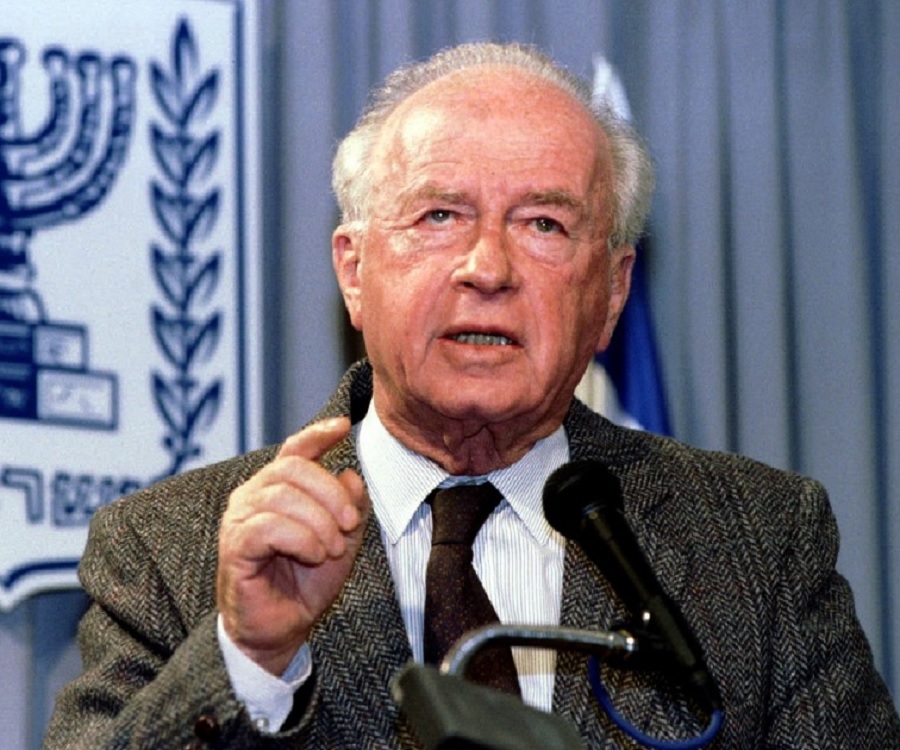 Yitzak Rabin ... and a photo of his
being shot and killed (November
4, 1995) by a right wing extremist Jewish
student Yigal
Amir 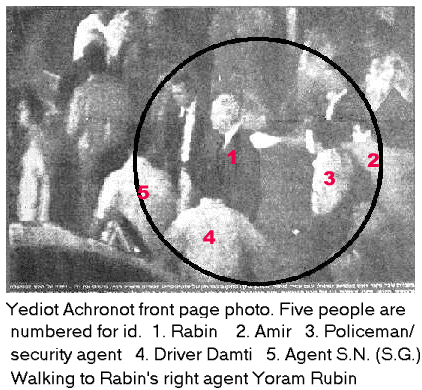 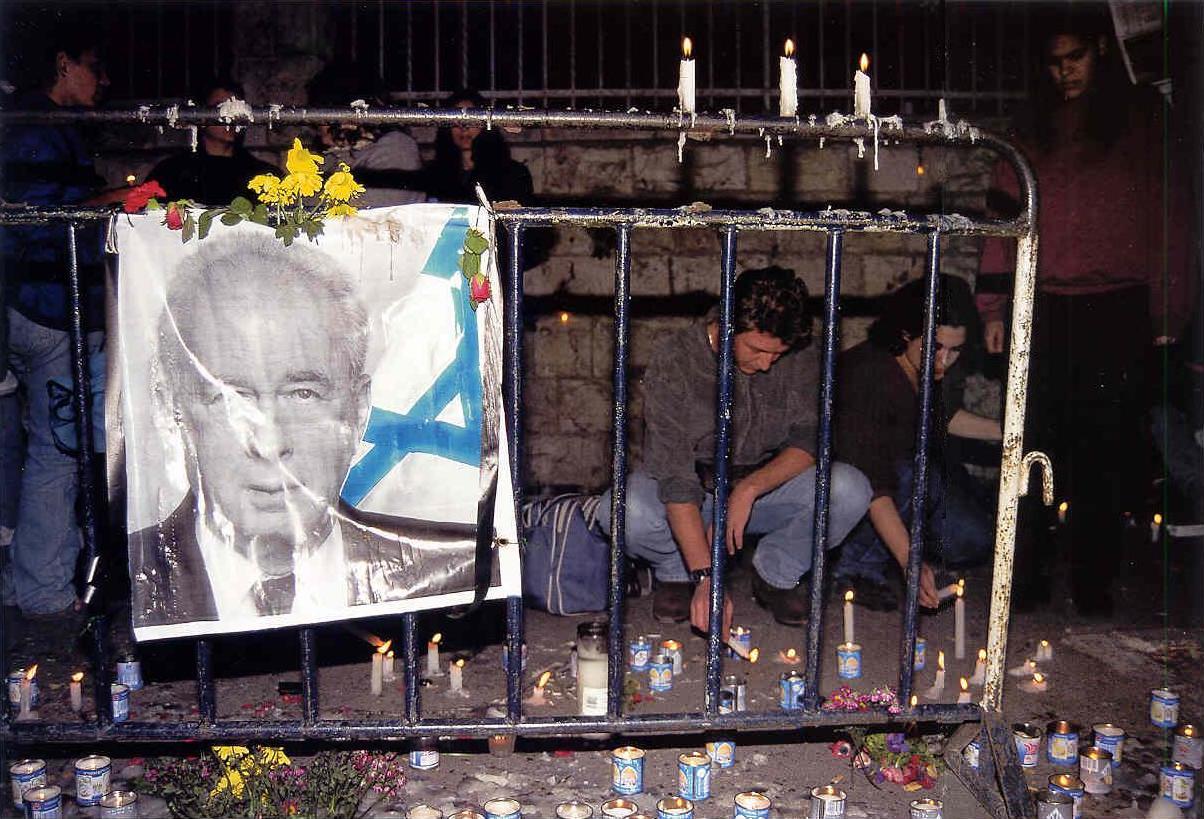
Mourning Yitzhak
Rabin
RESTORING HAITI'S PRESIDENCY (1993-1994) |
|
In 1994 in Haiti, Clinton was faced with a rapidly
deteriorating situation when a military junta – one that had overthrown
Haiti's first-ever popularly-elected government of Jean Bertrand
Aristide several years earlier – was holding on to power through very
repressive means. This event had set Haitians in huge numbers (tens of
thousands) fleeing the country, heading for America by sea, but with
many of the overloaded and unseaworthy boats sinking along the way.
The sheer horror of it all caused the United Nations to call for the
restoration of the elected government of Aristide – and again to look
to America for help. But in this matter, Clinton was again inclined to
be quite circumspect, because of the Somali disaster. Sensing however
that he had the broader support of the Haitian people themselves in
this matter, Clinton finally decided that the situation in Haiti could
be fairly rapidly reversed with some American intervention, and sent
representatives (former President Carter, General Colin Powell of Gulf
War fame, and Senator Nunn) to Haiti to let the junta know that if the
Haitian military did not immediately return Aristide to power, U.S.
troops would be sent to their country and bring about the same result.
The junta however thought it might just be a bluff, and did not respond
to the threat.
Thus in September Clinton ordered the
shipment of 20,000 U.S. troops of the 82nd Airborne Division to Haiti.
Finally, as the ships drew closer to Haiti, the Haitian military
understood that Clinton was not bluffing. Consequently, the Haitian
military backed down, agreeing to restore Aristide to power the next
month, under the protection of U.S. troops that were indeed put ashore
in Haiti to oversee this transfer of power. The U.S. troops were then
soon pulled out. Clinton came away from this venture looking very
presidential.
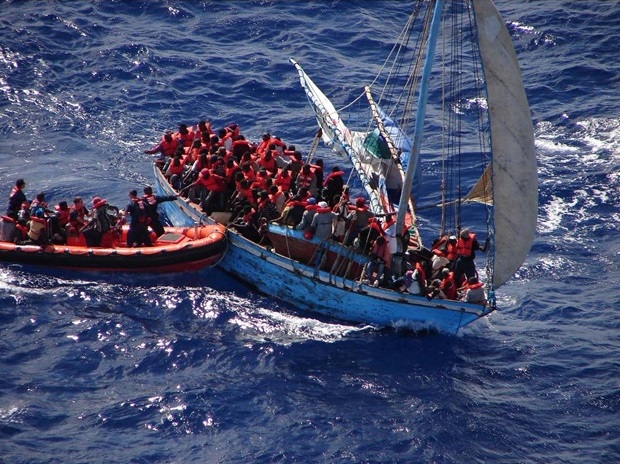
Haitian "boat people" being intercepted
by US agents
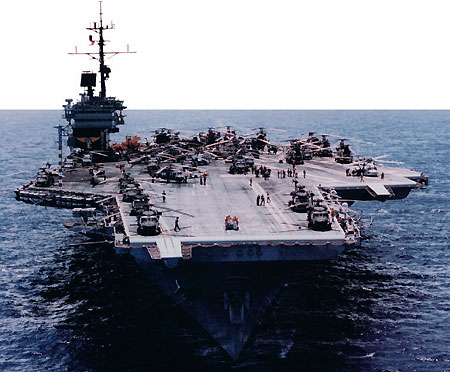
Carrier USS-America headed for Haiti
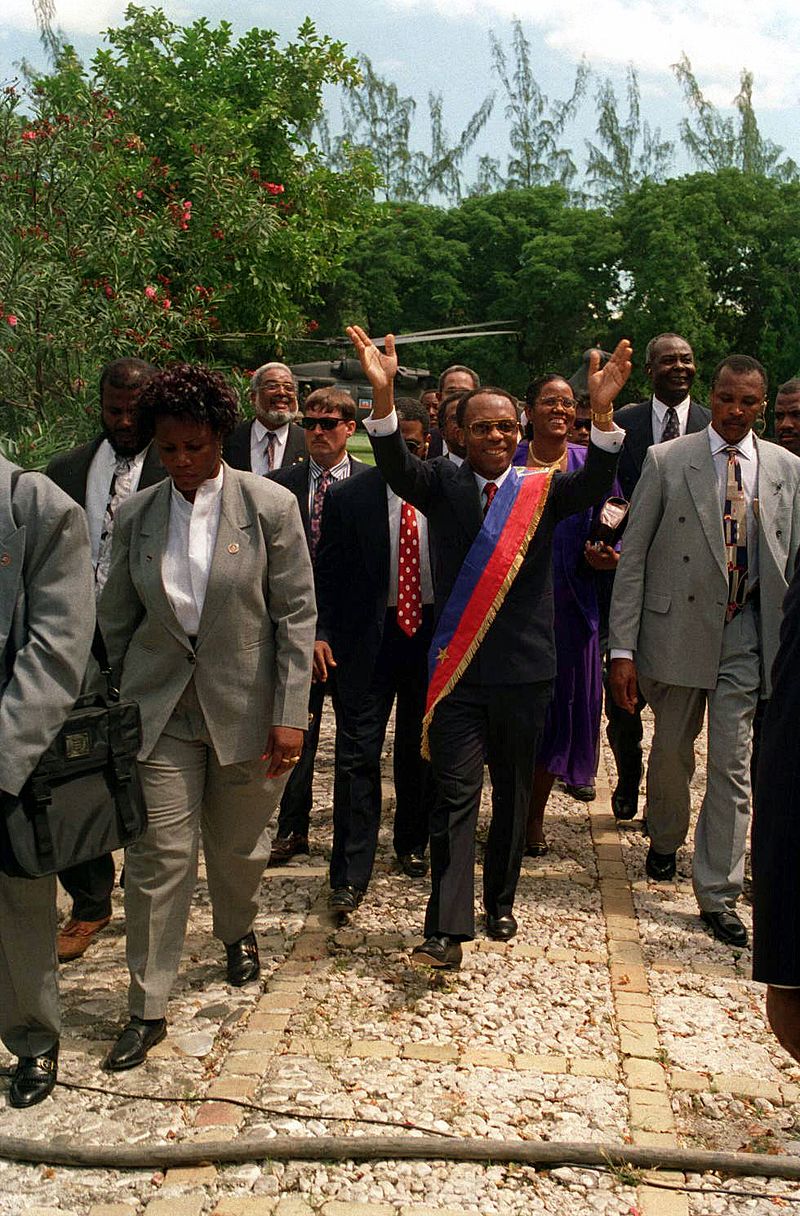 Aristide on his return to Haiti 
Troops restore Aristide in
Haiti – 1994
ETHNIC CLEANSING IN RWANDA (1994) |
|
In 1994 in Rwanda, the government (mostly of the
Hutu tribe) conducted a campaign of ethnic cleansing (almost a million
people killed in this tiny country) against the Tutsi tribesmen. An
appeal went out for the West to help. But this time Clinton reasoned
that this event had more the character of the Somali situation than the
Haitian situation, and simply refused to get involved. It was too big.
He drew a lot of fire from Liberals for his insensitivity. But he was
undoubtedly quite correct in not dragging the country into something
this big, and rather remote from America's direct interests.
|
ETHNIC CLEANSING IN BOSNIA (1991-1995) |
|
When Yugoslavian President Tito died in 1980, a
wide variety of South Slav national groups fell into infighting. In the
early 1990s some of these groups (Roman Catholic Croats and Slovenians)
declared independence from Serb-dominated Yugoslavia (largely Eastern
or Serbian Orthodox Christians). Bosnia-Herzegovina also declared
independence (1991), except that this area included a very large
Serbian minority (31 percent). The Yugoslavian Serbs refused to
recognize this independence and moved into Bosnia, which was also 44
percent Muslim (ethnic Slavic, although thanks to several centuries of
Turkish domination, mostly Sunni Muslim in religion), 17 percent Croat,
and 8 percent "other") to link up with their fellow Bosnian Serbs –
sparking a savage civil war in Bosnia.
The Serbs hit particularly hard the
Muslim areas of Bosnia, attempting to either kill or force into flight
all Muslims from the region (some 8,000 Muslim men and boys were killed
in the town of Srebrenica alone in 1995). Of course the Muslims struck
back where possible. The beautiful multi-ethnic Bosnian capital,
Sarajevo, the site of the 1984 Olympic winter games, was turned into a
bombed-out city. Subsequent ethnic cleansing drew the condemnation of
both the United Nations and the Western European countries. But there
was little they could do militarily, unless they employed NATO in some
kind of peace-keeping policing capacity. For that they would need
American leadership.
At first Clinton was hesitant to act
militarily (he had embargoed military sales to the Serbs), partly still
remembering the trouble U.S. forces had got themselves into in Somalia.
But by 1995, atrocities in Bosnia had become so bad – and such a threat
to the general peace and stability of Europe – that Clinton finally
agreed to use NATO air power against the Serbs in order to protect the
Bosnian Muslim towns and countryside from wholesale slaughter. Military
aid to the Muslims coming from other Muslim countries, plus help from
the Croatian military, put ground troops in action against the Serbs.
Finally toward the end of 1995 an
armistice, then a formal peace treaty (the Dayton Accords), backed up
by the placing of a 60,000-troop monitoring force (which included
20,000 U.S. troops) brought an uneasy peace to the area. By this time a
quarter of a million people had been killed and more than a million
made homeless by the war. Clinton hoped to achieve a multi-ethnic
Bosnia with its own government. But his NATO allies were dubious that
this would hold without long-term NATO enforcement, and preferred
simply to let Bosnia be subdivided by ethnic areas of Muslim, Serb and
Croat sectors. Also the NATO force, supposedly there for just one year,
had to be continued, although it was reduced to half the original size.
Here seemed to be an example of limited
but moderately effective nation-building. It had proved very costly.
But it seemed to settle this horrible crisis that had exploded right in
the heart of Southern Europe. And Clinton's America had clearly played the
key leading role in the event.
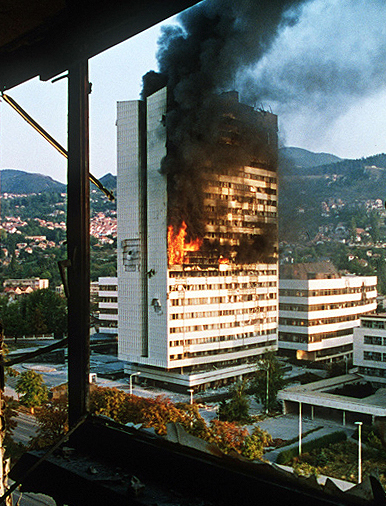
The building of the Parliament
of Bosnia and Herzegovina burns after being hit by Serbian
tank fire during the siege in 1992 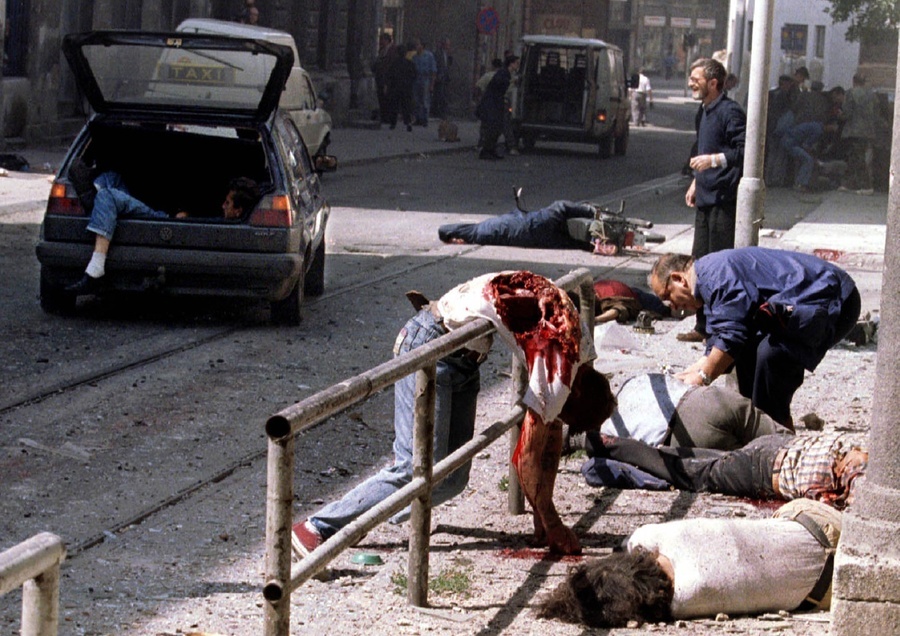
Sarajevo itself became a slaughterhouse as hostile forces fired across
streets,
catching civilians in the cross-fire.
In 1995 President Clinton (urged on by America's European allies)
decides that it is time for America to act ... to end this European
tragedy 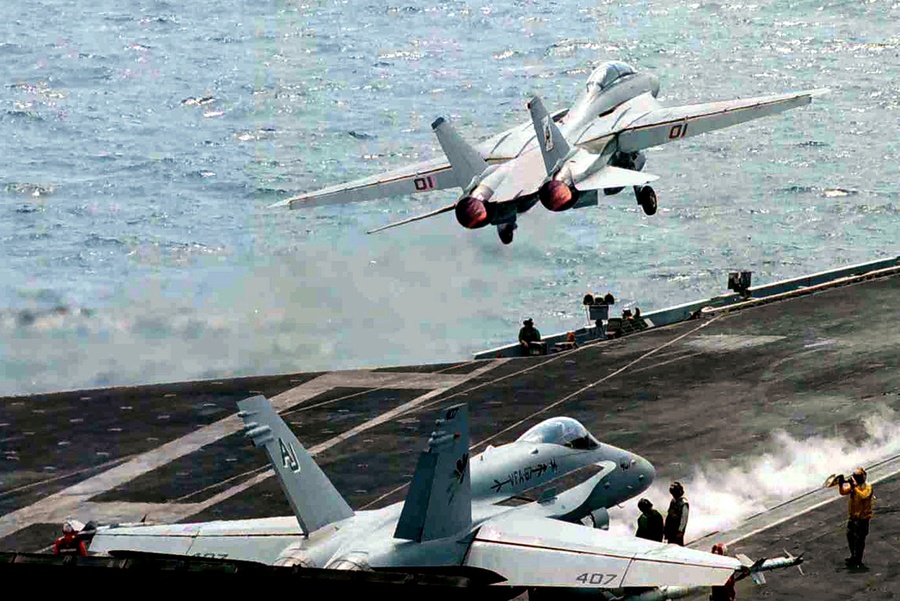
A US F14 tomcat fighter takes off on a patrol over Bosnia from the
aircraft carrier USS Theodore Roosevelt
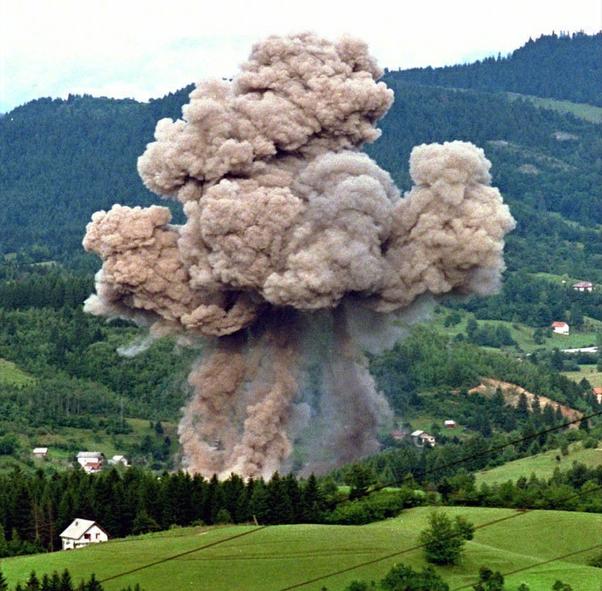 August 1995 – NATO airstrike of a Serbian
ammunition depot in Bosnia 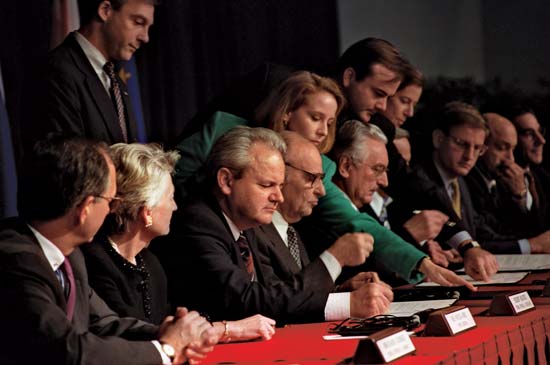
The signing of the Dayton Accords by
the presidents of Bosnia, Croatia and Serbia
in Ohio – November 21, 1995 ... organized by US chief negotiator Richard Holbrooke
and Secretary of State Warren
Christopher
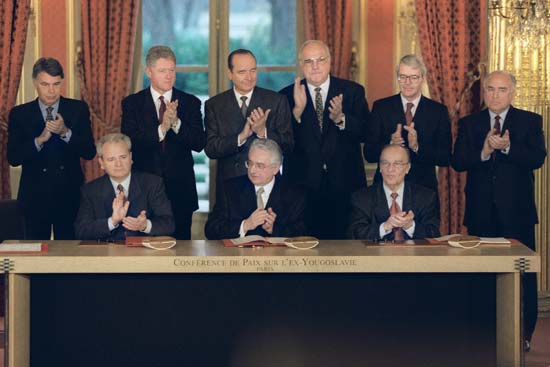
The final peace agreement is signed in
Paris December 14, 1995. Seated are Slobodan Milošević (Serbia), Franjo Tudjman
(Croatia), and Alija Issetbegovic
(Bosnia Herzegovina). Standing
behind them are Felipe Gonzalez (Spanish Prime Minister),
Bill Clinton,
Jacques Chirac (French President), Helmut Kohl (German Chancellor),
John Major (British Prime Minister) and Viktor Chernomyrdin. (Russian
Prime Minister)
|
Then in 1999 tensions flared up again in the
former Yugoslavia. This time it shifted to the southern Serbian
province of Kosovo where the vast majority of the population was
ethnically Albanian and Muslim in religion. Once again it was a Serbian
policy of attempting to remove non-Serbs from the region through a
program of ethnic cleansing that sparked a new civil war.
This time Clinton took the lead to call
for action against the Serbs, and immediately NATO responded with an
intense precision-bombing campaign that ravaged Serb troops and
military sites. Even the Serb capital of Belgrade was bombed
extensively to force the Serbs to back off (they had driven over a
million Albanians out of their homes and into neighboring countries as
refugees).
Finally Serbian President Milosevich had to
admit defeat. He agreed to remove his Serb troops from the Kosovo
Province and allow another NATO-staffed United Nations peacekeeping
force (50,000 troops, including 7,000 Americans) to police the
province. Milosevich was subsequently arrested as a war criminal and
sent to The Hague, where he died in a Dutch prison during his long
trial. And an 11-foot gold-colored statue of Bill Clinton, atop an even
taller pedestal, now sits in the center of Priština, the capital of
independent Kosovo, honoring the man who helped stop the ethnic
cleansing going on there!
|
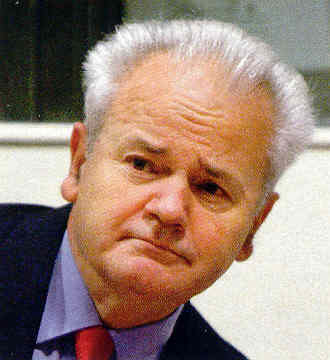
Serbian President Slobodan Milošević
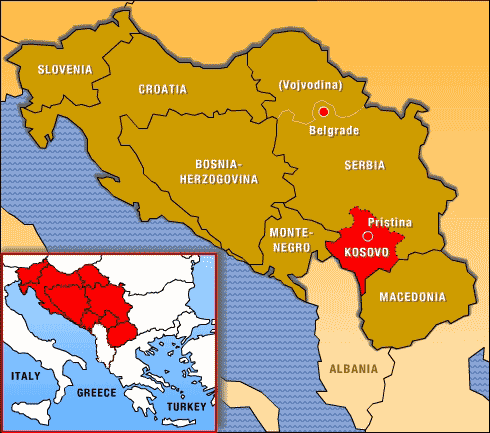
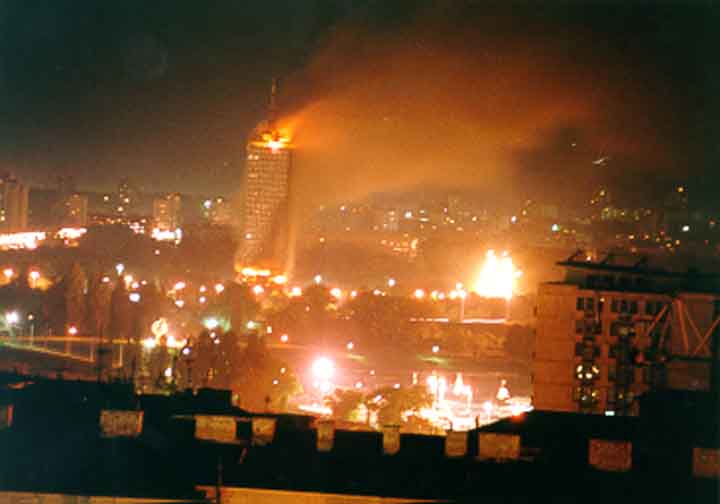 The 1999 NATO bombing of Serbia's
capital
Belgrade
The 1999 NATO bombing of Serbia's
capital
Belgrade
 A statue of Bill Clinton in downtown
Pristina, Kosovo's capital city!
A statue of Bill Clinton in downtown
Pristina, Kosovo's capital city!
RELATIONS WITH OUR FORMER COLD-WAR RIVAL RUSSIA NOW SEEM TO BE QUITE WARM |
|
Clinton enjoyed friendly relations with Boris
Yeltsin, President of the old national rival Russia – although
Americans generally stayed removed from Russian events as Russia moved
toward "democracy."
Once again Americans tended to believe that democracy, being the
natural instinct of man, would take care of itself in Russia now that
the oppressive restraints of the Soviet system had been lifted. Once
again Americans were wrong.
The Russian experiment with democracy was a huge disappointment to
multitudes of Russians who did not understand the personal duties and
responsibilities that democracy requires, but did understand that the
state no longer sent them their pension checks and that their alcoholic
President Yeltsin seemed to be more interested in enjoying himself than
in taking care of his people – which, to be taken care of, is what
Russians by tradition expect of any government, whether Tsarist,
Communist, or Democratic.
By the end of the 1990s, Russians (though by no means all of them, for
there were a number of younger, entrepreneurial Russians making great
economic gains in all this freedom) were becoming disenchanted with
Russia's attempt to join Western culture.
|
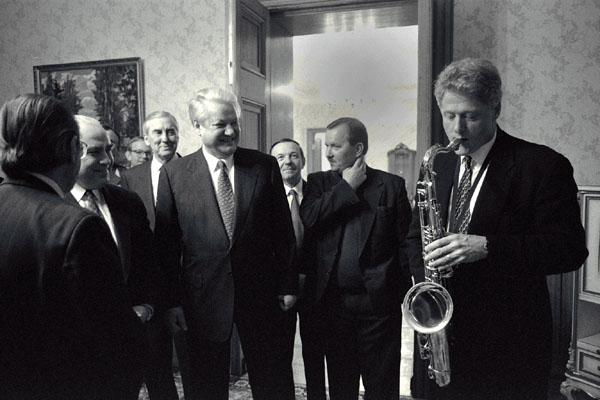
President Bill Clinton
plays the saxophone presented to him by
Russian President Boris Yeltsin
at a private dinner hosted
by President Yeltsin
at Novoya Ogarova Dacha, Russia – 13 January
1994
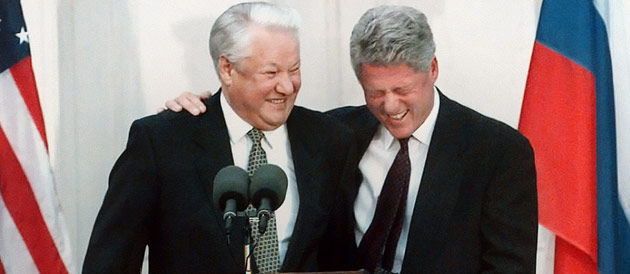
Yeltsin and Clinton having
a good laugh together during Yeltsin's visit to the US in
1995
DIPLOMATIC PROGRESS IN EUROPE |
|
In 1993 the foundation of the European Community
was strengthened in another step toward full political union with the
coming into force of the Maastricht Treaty. The biggest change that
came with the remake of the Community as the European Union was the
decision to abandon the members' national currencies (the British, as
often the case, not willing to move forward to that extent) such as the
mark, the franc, the lira, etc. – and instead to adopt an all-European
single currency, the euro. Soon thereafter (1995) three European
countries that had long taken a rather "neutral" position in the Cold
War, Sweden, Finland and Austria, also joined the European Union,
bringing the total membership to fifteen in number.
In March of 1999 the Czech Republic,
Hungary and Poland were added to NATO. The following year the rest of
the former members of the Soviet-dominated Warsaw Pact of East Europe
... as well as the Baltic states of Estonia, Latvia and Lithuania
petitioned to join NATO (they were finally brought into the alliance
formally in 2004). This now extended the reach of NATO deep into
Eastern Europe, once the sphere of influence or dominance of
Russia. Russia objected, but was not in a position to stop the
expansion. By 2017 the total number of NATO members stood at
twenty-nine.1
1The
original members who joined in 1949 were Belgium, Canada, Denmark,
France, Iceland, Italy, Luxembourg, the Netherlands, Norway, Portugal,
the United Kingdom and the United States. They were joined by Greece
and Turkey in 1952, West Germany in 1955, and Spain in 1982. Several of
the new states drawn from the former Yugoslavia would also join in 2004
and 2009. Ukraine also wanted to join – but that was considered too
provocative to the Russians and thus no action was taken. Sweden,
Finland, Austria and Switzerland chose to stay out of NATO as European
"neutrals."
|
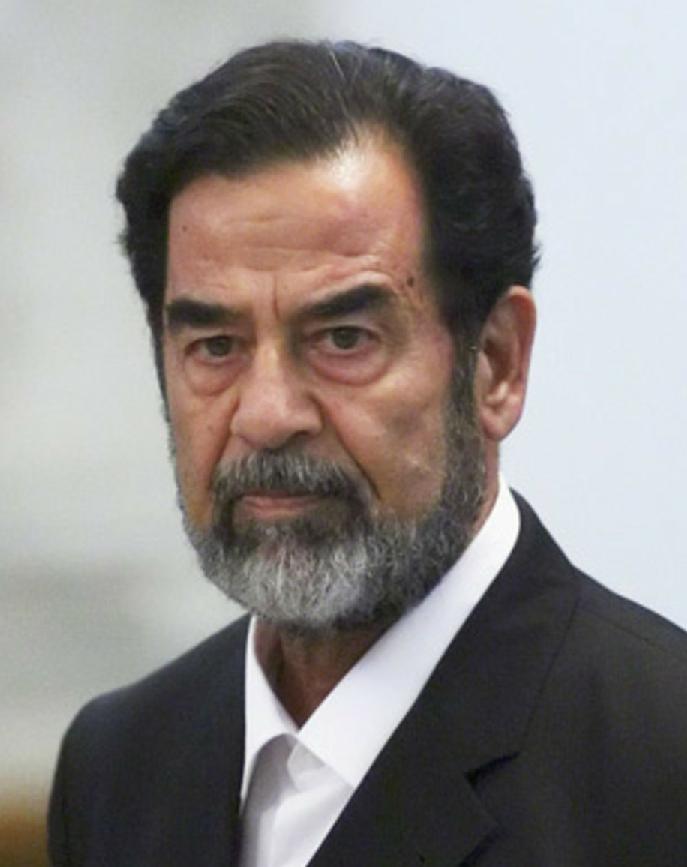
Through
the rest of the 1990s, Americans continued to watch Saddam Hussein
closely, to see if he would attempt to violate the post-Gulf-War
agreements forbidding the holding of chemical or biological weapons, or
the development of nuclear energy. In 1981 the Israelis had conducted a
devastating air attack on an Iraqi nuclear reactor under construction,
and the fear always remained that Saddam would try even harder to get
nuclear power going, secretly of course. United Nations inspection
teams were generally allowed to search Iraqi sites, although not
always. Tensions increased through the 1990s as America and Britain
claimed that Saddam was obstructing the international inspections he
had been forced to agree to.
In October of 1998 Clinton signed the
Iraq Liberation Act, giving American financial aid to Saddam's Iraqi
opponents, and then in December of 1998 Americans and British launched
four days of missile strikes on Iraq (Operation Desert Fox), announced
as an effort to degrade Saddam's ability to develop "Weapons of Mass
Destruction" (WMDs). Actually the operation was also an attempt to
cripple Saddam's regime, even bring it down if possible. Thus most of
the sites bombed were military installations, not industrial production
sites.
Despite achieving serious damage to Iraq,
mostly these operations irritated America's and Britain's Arab allies,
such as Saudi Arabia, Bahrain and the United Arab Emirates, which
refused to let America and Britain use their lands from which to
conduct their attacks on Iraq. Thus the attacks had to be launched from
American and British fleets in the Persian Gulf. Also Russia, China and
even France reacted very negatively to these operations, demanding of
the United Nations Security Council that the boycott of Iraqi oil sales
finally be lifted.
Cynics at home even stated that these
attacks were designed to distract the American public from the
spotlight that was on Clinton, because of a scandal rocking his
presidency at that same time – over allegations that Clinton had been
involved in a sexual affair in the White House with a young (and
ambitious) White House intern.
Possibly. But Clinton was also on edge
because of tragic events aimed at America that had been taking place
earlier, some such events only a few months earlier, events undertaken
by Arab Muslims with plans for destruction and death of Western
society, American society in particular. Saddam's role in sponsoring
such activity was not clear. But he certainly approved of these events.
Thus a show of force seemed to be required. It seemed to be a case of
destroy or be destroyed.
|
PROBLEMS BREWING IN THE MUSLIM WORLD |
|
Indeed, events in the second half of the 1990s
that would soon come to have great significance to America were taking
place in Afghanistan, events which at the time drew little attention
from the world (except from the CIA which was watching developments
closely). A group of religious diehards, the Taliban, were in the
process of taking over all but the very northern portions of
Afghanistan.
Afghanistan was well-recognized as being
a relatively ungovernable country, inhabited by numerous tribes and
ethnic groups with a long history of mutual hatred. Since the downfall
of the Afghan Shah in 1973 Afghanistan had been, with frequent Soviet
interference, ruled by various mutually hostile factions of the Afghan
Communist Party. Then with the final collapse of the pro-Soviet
government and the creation in 1992 of the Islamic State of
Afghanistan, the schisms switched from ideological differences to
strictly personal, tribal and ethnic differences, merely continuing the
politically unstable situation.
The Pashtun tribesmen, living in the
south and southeast of the country, were the largest of the ethnic
groups – and long-accustomed to running the country, even though they
comprised only a little over 40% of the Afghan population. Tajiks made
up not quite 30%, Hazara not quite 10%, Uzbeks also not quite 10%, and
the other 10% a mixture of other tribes. Afghanistan was thus not truly
a nation, but merely a collection of nations – which made the idea of
building a democracy in Afghanistan very complicated, if not totally
unlikely to ever come to pass.
With the creation in 1992 of the Islamic
State of Afghanistan, the country was plunged into a vicious civil war,
with various alpha males representing Afghanistan's various tribal
groups fighting among themselves, switching loyalties as their
perceived self-interests shifted back and forth.
But in 1994 the civil war was joined by
yet another small group of mostly Pashtuns, formed around the
leadership of an Islamic fundamentalist teacher, the mullah Muhammad
Omar, and his students or taliban.
The Taliban were mostly Afghans who had originally fled Afghanistan and
had established themselves with the Mullah Omar in the Pastun regions
of Pakistan.2 The
Taliban began to grow rapidly in number, drawing madrasah (religious
school) students and young ideologically-inspired militants from among
the huge Afghan refugee population in Pakistan. But it also began to
draw membership from Islamic fundamentalists from all around the Muslim
world because of its well-known commitment to the strictest form of shari'a,
Islamic social and religious law. Also, various elements of the
Pakistani government, particularly its intelligence service, the ISI
(Inter-Services Intelligence), began to give considerable support to
the Taliban.
In 1994 the Taliban crossed from Pakistan
into Afghanistan and easily seized the key southern city of Kandahar
(well placed within Pashtun territory) – where the political reach from
Afghanistan's capital city Kabul had been virtually non-existent
anyway. The Taliban then made Kandahar the center of their operations.
They became famous for their ruthless grip over the local population,
imposing the strictest Islamic political order through a reign of
Islamic terror: conducting executions for various offenses, especially
ones committed by women. Local Shi'ites (disdained by the Sunni Taliban
who considered all Shi'ites as heretics) and ethnic Hazaras (whom the
Pastun looked down on as a greatly inferior class of people) also came
under the wrath of the Taliban (tens of thousands were simply executed
for the sin of being Shi'ite or Hazara). But this brutal intimidation
of the local population worked. Villages were afraid to come up against
the Taliban. And soon the southern or Pashtun section of Afghanistan
fell under their strict rule.
Attempts were made by the Kabul
government, in particular by Afghan Defense Minister, Ahmed Shah
Massoud, to draw the Taliban into a national coalition. But the Taliban
were not interested. With strong support coming from the governments of
Pakistan and Saudi Arabia – and from a new Pakistani-based jihadist
organization, al-Qaeda – the Taliban were able to advance their troops
on the capital Kabul. In September of 1996 they surrounded the city,
forcing the government to evacuate and retreat to the northern
provinces, where what was left of the original Afghan government
managed to continue to hold out under the leadership of Massoud.
The United Front or Northern Alliance
Afghans soon were streaming north to the
Massoud-led "Northern Alliance" in order to escape the on-going
massacre by the Taliban. By 2001 over a million refugees had fled
various parts of Afghanistan to find refuge in Massoud's north. And
Massoud had begun efforts to organize this chaotic situation into
something of a stable, western style republic which he hoped would soon
bring the country out of the increasingly harsh rule of the Taliban.
Meanwhile Pakistan, once a modernizing,
staunchly pro-Western ally, was sending tremendous amounts of aid to
the Taliban. From the American point of view this made little sense,
for certainly Pakistan had to realize the danger that the Taliban
presented to Pakistan's own government. Presumably Pakistan believed
that by backing the Taliban, they had this militant organization under
better Pakistani control. That would prove to be a very wrong
assumption.
Al-Qaeda (or more properly al-Qa'ida)
Another jihadist group with a huge global
mission, even beyond the Middle East, was Arab al-Qaeda. It was founded
in the late 1980s by Sunni Arab Muslims through another organization,
Egyptian Islamic Jihad, but was heavily supported with Saudi Arabian
financing – and led by a Saudi expatriate, Osama bin Laden. Bin Laden
(son of a very wealthy Saudi construction contractor) took refuge in
the Sudan in 1992 after being expelled from his native Saudi Arabia by
the Saudi king because bin Laden had been loud and long in his verbal
attacks on the Saudi government for permitting American troops to be
stationed in the country during the 1991 Gulf War.
According to Islam, all of Arabia is holy ground. The stationing of kaffirs
(infidel or unbelievers) anywhere in Arabia is a great sin against
Allah. But the Saudi king knew he needed the presence and protection of
American troops in Saudi Arabia against the expansionist designs of
Saddam Hussein. Thus Bin Laden's unrelenting religious purism had
become intolerable to the Saudi royal family.
At the same time, the military government
of the Sudan initially proved very supportive of bin Laden's sense of
religious mission, and permitted the establishment in their country of
training bases where young Muslim militants could be instructed in the
art of Islamic Jihad. But when al-Qaeda began to be involved in attacks
on neighboring Arab governments – notably, an attempted assassination
of Egyptian President Mubarak in 1995 – Sudanese authorities decided
that it was better to send bin Laden and his organization on its way
(1996).
At this point bin Laden and his
organization moved part of their operations to Afghanistan, where the
Taliban allowed al-Qaeda to set up new training camps. Meanwhile, next
door in Pakistan, bin Laden's operational headquarters drew vital and
increasing (but secret) support from Pakistani governmental and
military officials who wanted to see Pakistan look less Secular Anglo
and more Sunni Arab in profile.
Al-Qaeda's goals were from the very
beginning to spread Islam to the world by whatever means necessary,
replacing Western influences (whether Secular or Christian) with
Islamic domination (the Sunni version of Islam, of course). Early on it
became involved in all sorts of very violent bombings and
assassinations, such activities soon becoming its well-recognized
professional hallmark. Besides its military training camps in
Afghanistan and in the tribal lands of Pakistan, it set up cells of
jihadist "operatives" in cities all around the world, training young
men (and women) in the art of suicide bombing (to the glory of Allah,
the great rewarder of suicidal jihadism). And al-Qaeda infiltrated
mosques everywhere, demanding the preaching of a very militant version
of Islam.
In a way, it found itself in competition
with Iran (Iran being the fatherland of Shi'ite Islam) to see whether
Sunni or Shi'ite Islam would be the first to conquer the world.
2It
is important to note that the old British border, the so-called Durand
Line of 1893 between Pashtun Afghanistan and Pashtun Pakistan has never
been respected by the Pashtun, who in this mountainous border region
tend to honor no government at all anyway, Afghani or Pakistani.
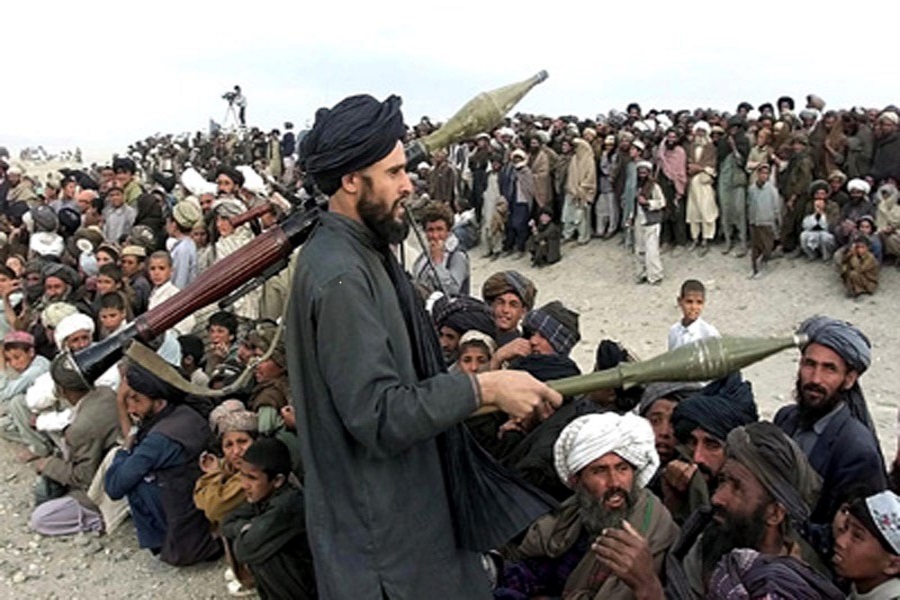
The Taliban after the takeover of Kabul
(and thus most of the country
... except for the Northern Provinces still held by
Massoud)
The bombing of the World Trade
Center in New York on February 26, 1993.
|
In late February of 1993 a van parked in the
parking garage of the North Tower of the World Trade Center exploded,
knocking out six stories of the building, killing six people and
injuring over a thousand others. It had been parked in such a way that
it was intended to knock the North Tower over onto the South Tower and
bring both down, killing tens of thousands of people. Had the van been
parked closer to one of the main supports of the North Tower, the bomb
might have achieved its objective.
Enough evidence was left behind in the rubble
that eventually the trail of conspiracy led back to a number of Muslims
trained by al-Qaeda, and advised and financed by the Pakistani al-Qaeda
member Khalid Sheikh Mohammed,3
the uncle of the individual, Ramzi Yousef, who actually directed the
bombing of the World Trade Center. The trail also led through a couple
of American mosques, one in Jersey City and another in Brooklyn, which
were led by rabidly anti-American mullahs (Islamic priests). Gradually,
one by one, most of the conspirators were found, still in the United
States, and arrested. One who got away ended up in an Iraqi prison.
Efforts were made to connect the
al-Qaeda-directed event to Saddam Hussein, but extensive FBI
investigations came up with no apparent connection. Nonetheless,
al-Qaeda now came to the top of the list of terrorist organizations
that American authorities were watching closely.
3Khalid
Sheikh Mohammed would also be the mastermind of the second or 9/11
attack on the World Trade Center's two towers in 2001.
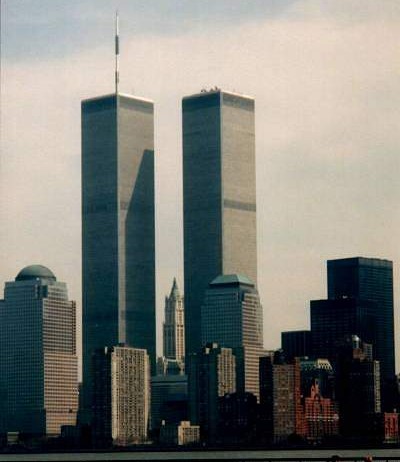 The World Trade Center in New York
City
The World Trade Center in New York
City
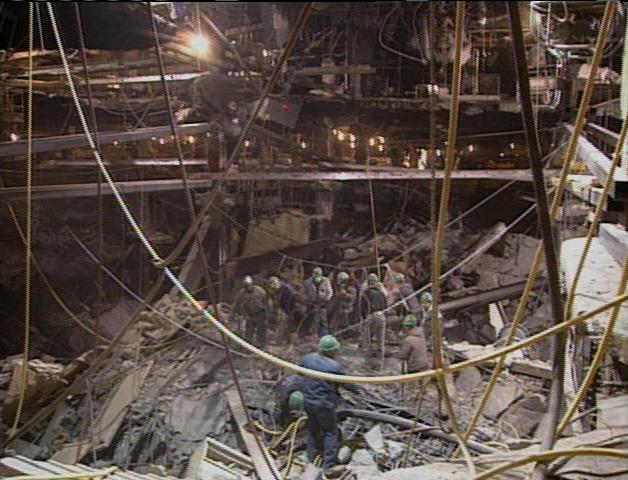
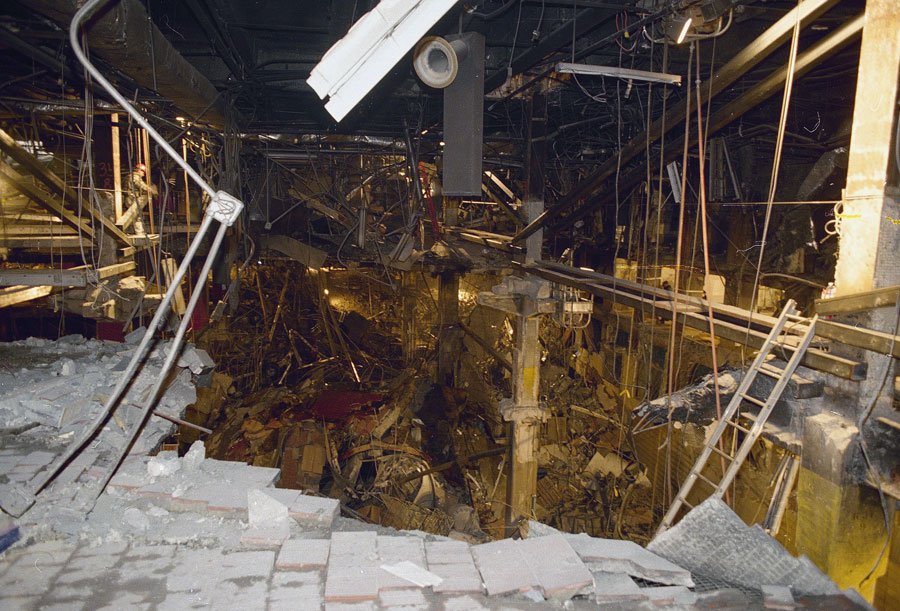
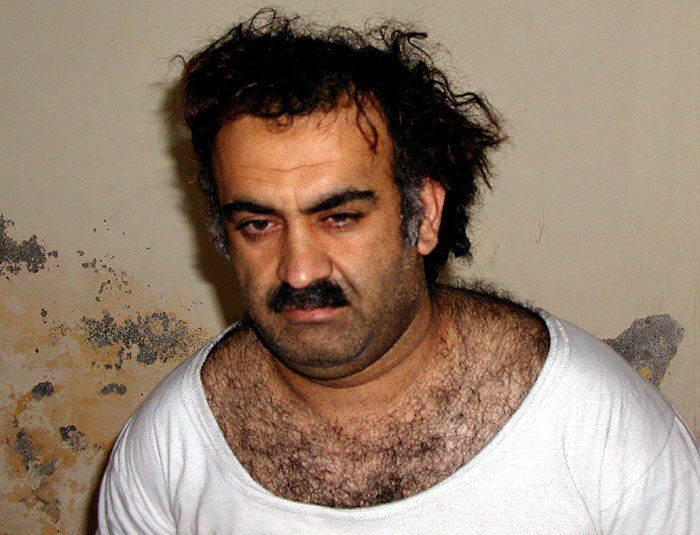
Khalid Shaikh Mohammed, upon
capture – March 2003. He also masterminded the
second attack on the Twin Towers on 9-11, 2001
... as well as other attacks
on Western society
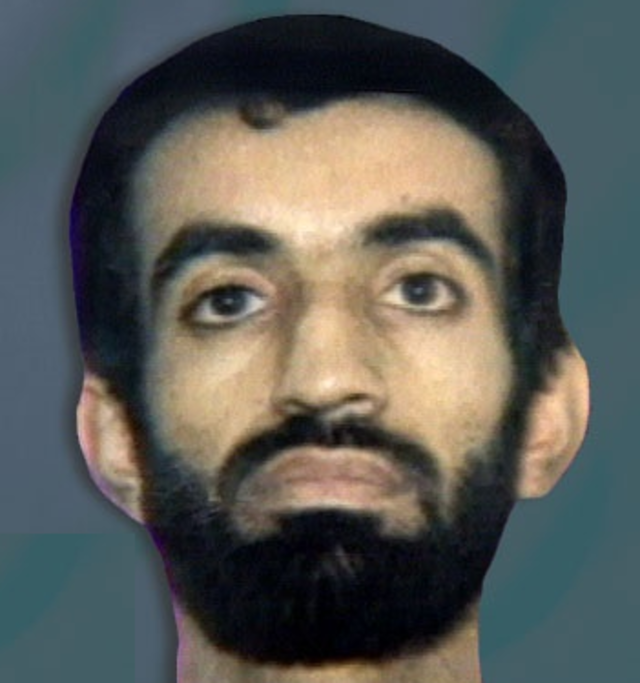
Ramzi Yousef – nephew of
Khalid Shaikh Mohammed
and operational leader of the 1993 WTC
attack
|
The attack on American embassies (1998)
In August of 1998, American embassies in Dar es
Salaam (Tanzania) and Nairobi (Kenya) were extensively ravaged in
bombings in which 212 people were killed. The CIA quickly identified
al-Qaeda, (actually its Egyptian branch, Egyptian Islamic Jihad) as
responsible for the bombings. In response Clinton immediately ordered
cruise missile strikes on Afghan and Sudanese targets where al-Qaeda
had either training camps or supposedly bombing supplies. Ultimately
nothing much came of the American response, except a large outcry from
a lot of Arabs.
|
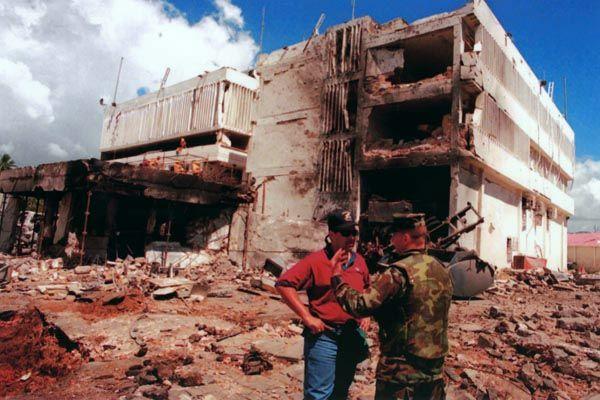
The U.S. Embassy in
Dar es Salaam, Tanzania,
in the aftermath of the
August 7, 1998, al-Qaida suicide bombing
| "The U.S.
Embassy in Dar
es Salaam, Tanzania, in the aftermath of the August 7, 1998, al-Qaida suicide
bombing. Eleven Tanzanians, including
7 Foreign Service Nationals, died in the blast, and 72 others were
wounded. The same day, al-Qaida suicide bombers launched another near-simultaneous attack on the U.S.
Embassy in Nairobi, Kenya, which
killed 218 and wounded nearly 5,000 others"
|
US Department of State
Records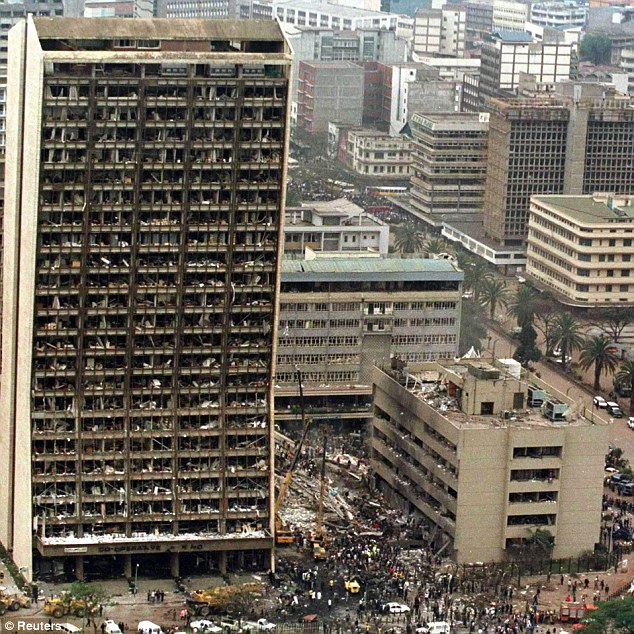
The U.S. Embassy bombing
in Nairobi, Kenya – August 7, 1998
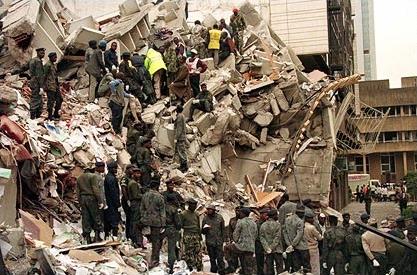
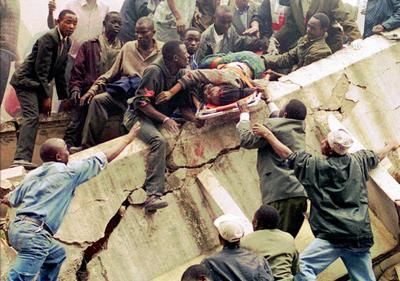
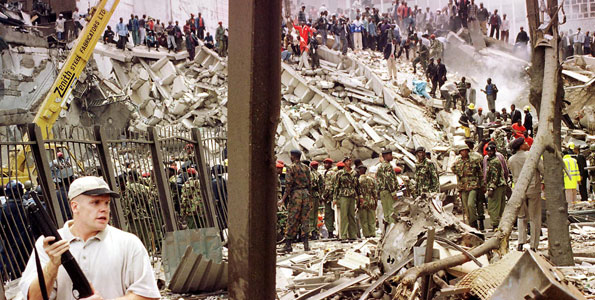 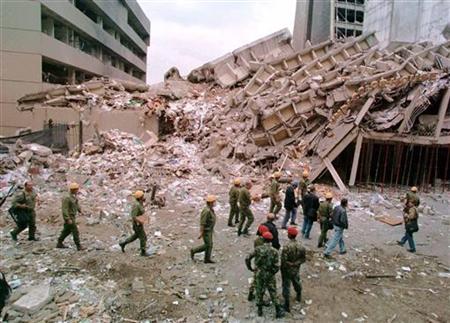 American retaliatory attacks
on al Qaeda training camps in Afghanistan and supposed supply depot in
the Sudan – August 20, 1998
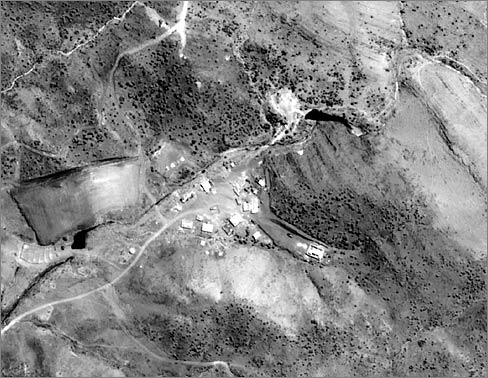
"1998 satellite image released
by the U.S. Government of an Al-Qaeda training camp at Zhawar Kili, Afghanistan
that was later bombed during Operation Infinite Reach"
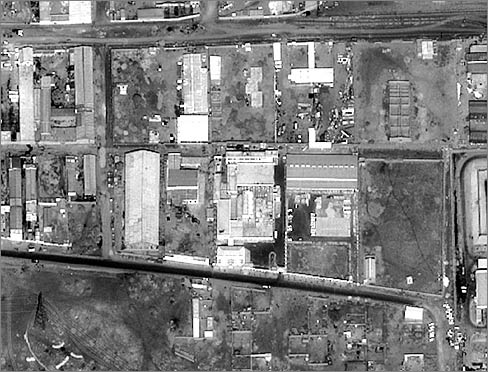
"1998 US Government
photograph
shows a suspected bioweapons production facility in Shifa, Sudan that the
U.S. destroyed in the wake of terrorist bombings
of the American embassies
in Kenya and Tanzania that year."

Go on to the next section: Major Domestic Events That Shake America
 Miles
H. Hodges Miles
H. Hodges
| | | | | |


 American intervention in Somalia (1993)
American intervention in Somalia (1993) Clinton's efforts to bring peace between
Clinton's efforts to bring peace between Restoring Haiti's presidency (1993-1994)
Restoring Haiti's presidency (1993-1994)
 Ethnic cleansing in Rwanda (1994)
Ethnic cleansing in Rwanda (1994)
 Ethnic cleansing in Bosnia (1991-1995)
Ethnic cleansing in Bosnia (1991-1995)
 Relations with former Cold War rival
Relations with former Cold War rival Problems brewing in the Muslim world
Problems brewing in the Muslim world











































